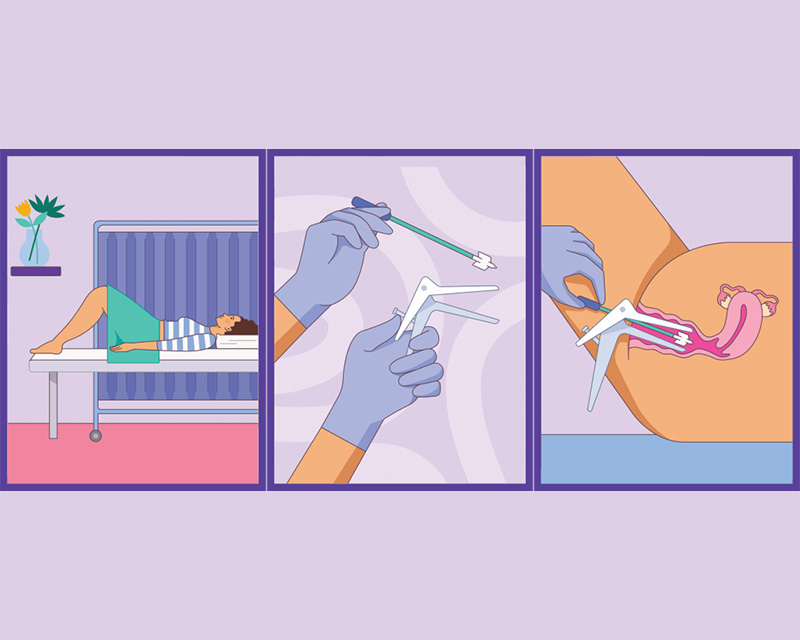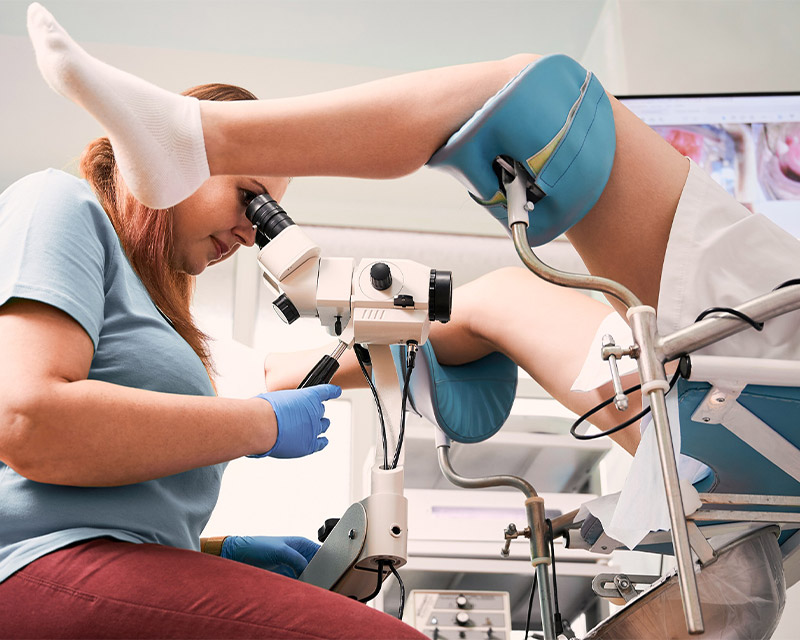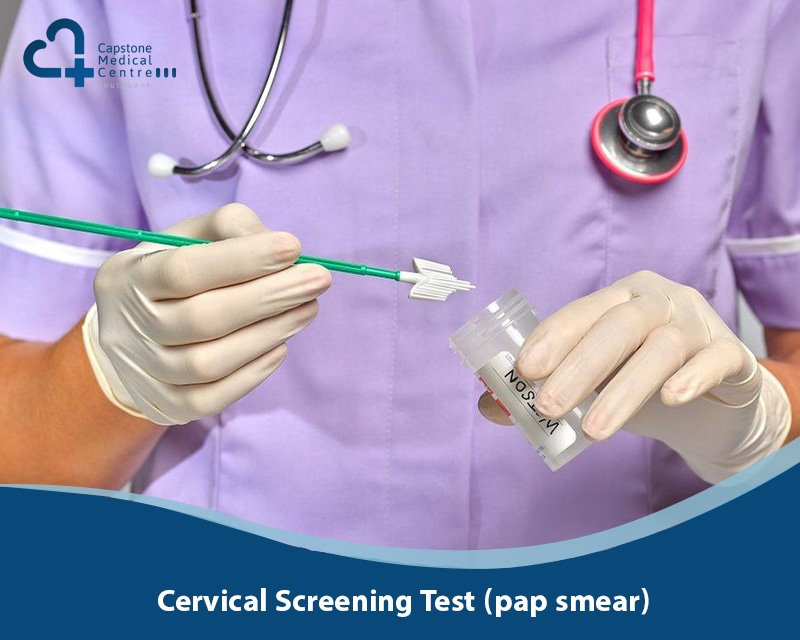The Cervical Screening Test, or Pap smear, is essential for women’s health, detecting cervical cancer early. By collecting cells from the cervix and examining them, abnormalities can be spotted before cancer develops.
In Australia, it’s advised that sexually active women aged 25-74 undergo this test every five Years. As early-stage cervical cancer often shows no symptoms, regular screenings are crucial.
This “Capstone Medical Centre” guide offers a comprehensive overview covering the test process, preparation, result interpretation, and post-test steps. It emphasizes the importance of regular screenings in the broader context of women’s health care.
Understanding Cervical Cancer
Cervical cancer is a type of cancer that occurs in the cells of the cervix. It is characterised by the abnormal growth and division of cells in the cervix, leading to the formation of a tumour. Cervical cancer is a serious health concern and is the fourth most common cancer in women worldwide.
In Australia, cervical cancer is less common, thanks to the widespread adoption of regular cervical screenings and the national HPV vaccination program. However, it still affects a significant number of women each year. Early detection through regular Cervical Screening Tests is key to successful treatment and survival.
One of the primary causes of cervical cancer is persistent infection with certain types of human papillomavirus (HPV). HPV is a group of more than 200 related viruses, of which more than 40 types can be easily spread through direct sexual contact. Most HPV infections don’t lead to cancer. However, some types of HPV can cause changes to the cells of the cervix, which can eventually lead to cervical cancer.
HPV types 16 and 18 have been identified as high-risk types because they are responsible for about 70% of all cases of cervical cancer. The HPV vaccine, which is part of the national immunization program in Australia, protects against these high-risk types of HPV, significantly reducing the risk of developing cervical cancer.
- Related Article: What is Gonorrhea?
What is a Cervical Screen Test (Pap Smear)?

The Cervical Screening Test, commonly known as the Pap smear, is a medical test used primarily to detect potentially pre-cancerous and cancerous processes in the cervix. Regular screening is the best protection against cervical cancer.
The test is named after the Greek doctor George Papanicolaou, who developed the technique. It involves the collection of cells from the cervix for microscopic examination. The main purpose of the test is to monitor the health of a woman’s cervix and to detect changes in the cells that might indicate conditions such as inflammation, infection, abnormal growth, or early-stage cervical cancer.
During a Pap smear, a healthcare provider uses a small brush or spatula to gently scrape a sample of cells from the surface and the cervix canal. These cells are then sent to a laboratory, prepared, and examined under a microscope.
The Pap smear is a screening tool, meaning it’s designed to detect potential problems, not diagnose them. If abnormal cells are found during a Pap smear, further testing is usually required to diagnose the specific condition and determine the appropriate treatment.
By detecting abnormal cells early, the Pap smear plays a crucial role in preventing and detecting cervical cancer. This is why regular cervical screenings are an essential part of women’s health care.
For more information on women’s health, find female doctors near you, and for comprehensive women’s health checks, please contact Capstone Medical Centre professionals.
Who Should Have a Cervical Screen Test?
In Australia, the guidelines for cervical screening recommend that all women and people with a cervix aged 25 to 74 have a Cervical screening test. This recommendation applies regardless of whether they have had an HPV vaccination. The test should be done every five years through their healthcare provider.
The Cervical Screen Test is important for all sexually active individuals with a cervix, regardless of their sexual orientation or activity. This is because the human papillomavirus (HPV), which can lead to cervical cancer, can be transmitted through any sexual activity involving genital contact—not just intercourse.
Regular cervical screenings are a crucial part of preventive health care and can help detect changes in the cervix’s cells before they develop into cancer. Early detection greatly increases the chances of successful treatment and survival.
- Related Articles: What is Chlamydia?
Preparing for a Cervical Screen Test

Preparing for a Cervical Screen Test involves a few simple steps:
- Scheduling the Test:
It’s recommended to schedule your Cervical Screen Test when you’re not menstruating, as blood can interfere with the results. The best time is usually between 10 and 20 days after the first day of your menstrual cycle.
- Hygiene:
On the test day, you can maintain your usual hygiene routine. Avoid using vaginal douches, tampons, or any vaginal creams or medications for at least two days before the test, as they may wash away or obscure abnormal cells.
- Concerns or Anxieties:
Feeling a bit anxious about the test is normal, especially if it’s your first time. Remember, the test is a routine procedure and is usually quick and painless. Some people might experience slight discomfort, but it’s typically over within a few minutes. If you’re feeling anxious, it can help to discuss your concerns with your healthcare provider before the test. They can explain the process in detail and answer any questions you have.
The Cervical Screen Test Procedure

The Cervical Screen Test, or Pap smear, is a relatively straightforward procedure typically performed in a healthcare provider’s office.
Here’s what you can expect during the test:
1. Preparation
You’ll be asked to undress from the waist down and given a paper or cloth covering. You’ll then lie down on an examination table with your knees bent and your feet placed in supports called stirrups.
2. Speculum Insertion
The healthcare provider will gently insert an instrument called a speculum into your vagina. The speculum is used to hold the walls of the vagina apart to provide a clear view of the cervix. You may feel a slight pressure or discomfort during this part of the procedure, but it should not be painful.
3. Cell Collection
The healthcare provider will then use a small brush or spatula to gently scrape or brush cells from your cervix’s surface and canal. This might cause slight discomfort or a feeling similar to menstrual cramps.
4. Sample Preservation
The collected cells are then preserved on a glass slide or in a liquid-based solution and sent to a laboratory for microscopic examination.
5. Speculum Removal
After the sample is taken, the healthcare provider will remove the speculum and complete your test.
The entire procedure usually takes just a few minutes. After the test, you may experience some spotting or light bleeding, which is normal. If you have any concerns or experience severe pain or heavy bleeding, you should contact your healthcare provider.
What Happens After the Test?

After the Cervical Screen Test, the collected cell sample is sent to a laboratory for analysis. The results are typically available within a few weeks.
There are several possible outcomes from the test:
1. Negative Test Result (Low Risk)
This means that no high-risk (cancer-causing) HPV was found on your cervix. You will be advised to return for another screening in five years.
2. Unsatisfactory Test Result
This means the lab couldn’t read your sample properly. You’ll need to return for a repeat Cervical Screening Test in 6 to 12 weeks. An unsatisfactory result doesn’t mean anything’s wrong. It just means the lab couldn’t read the test properly.
3. Return to Screen in 12 Months.
This means you tested positive for HPV but don’t need further investigation at this time. You’ll need to have another test in a year. There’s a good chance that your body’s immune system will get rid of the HPV in that time.
4. Refer to a Specialist
This means your results show either you tested positive for a type of HPV that needs further investigation or the test found abnormal cells that may need treatment. Your healthcare provider will refer you to a specialist (usually a gynecologist) for a colposcopy.
Remember, it’s important to discuss your results with your healthcare provider, who can guide you in the next steps based on your situation.
Interpreting Cervical Screen Test Results

Interpreting the results of a Cervical Screen Test involves understanding the different categories of results:
1. Normal (Low Risk): This means that no high-risk (cancer-causing) HPV was found on your cervix. You will be advised to return for another screening in five years.
2. Abnormal (Intermediate Risk): Your results show that you do not have HPV types 16 or 18 (the highest-risk types) but one of the other high-risk HPV types. You will be asked to return in 12 months for a follow-up HPV test, as your body will usually clear the infection (and any cell changes) during this time.
3. Abnormal (Higher Risk): Your test results show either HPV infection with types 16 and/or 18, high-grade cell changes on your cervix, or persistent infection with one of the other high-risk HPV types (not 16/18). It is important that you have a further follow-up because you may be at a high risk of developing cervical cancer.
4. Inconclusive (Unsatisfactory): An unsatisfactory test result occurs when the sample cannot be properly examined. There are several reasons why this may happen, including the number of cells being too small or not having enough liquid to perform all the tests needed. An unsatisfactory result does not mean there is an abnormality or a positive test, but it is important to repeat a test at the recommended time.
Abnormal results may indicate the presence of high-risk HPV types or abnormal cell changes that could potentially develop into cervical cancer if left untreated. However, it’s important to remember that an abnormal result does not necessarily mean you have cancer. Further testing is usually required to determine the cause of the abnormal cells and the appropriate treatment.
Benefits of Cervical Screening

The Cervical Screen Test, or Pap smear, is vital in preventing cervical cancer. Here are some of the key benefits of regular cervical screenings:
1. Early Detection of Abnormal Cells
The primary benefit of the Cervical Screen Test is the early detection of abnormal cells in the cervix. These cells may, over time, develop into cervical cancer if left untreated. By identifying these changes early, treatment can be started at a stage when the condition is most curable.
2. Prevention of Cervical Cancer
Regular screenings can help prevent cervical cancer by detecting high-risk HPV types that can cause cervical cancer. If these types are found, further testing can be done to look for abnormal cells.
3. Peace of Mind
Regular screenings can provide peace of mind, knowing you are taking proactive steps to maintain your health. If your test results are normal, you can be reassured that you have a very low risk of developing cervical cancer before your next screening.
4. Simple and Quick
The Test is a simple and quick procedure that can be done in a healthcare provider’s office. It’s a small investment of time that can significantly benefit your health.
5. Part of Routine Women’s Health Care
Regular cervical screenings are an essential part of routine women’s health care. They complement other important aspects of women’s health, such as breast screenings and regular check-ups.
Risks and Limitations

While the Cervical Screen Test is a crucial tool in the prevention of cervical cancer, it’s important to understand its limitations and address common misconceptions:
1. Not All Cases Prevented
The Cervical Screen Test will not prevent all cases of cervical cancer. Some people will still develop cervical cancer despite regular screening.
2. False Positives and Negatives
The test may suggest cervical cell abnormalities when there are none (false positive) or may not detect them even though they are present (false negative).
3. Missed Abnormalities
Some abnormal cell changes may be missed. You can test negative for types of HPV and still develop cervical cancer.
4. Misconceptions
There are common misconceptions about the Cervical screening test. For example, 1 in 5 people mistakenly believe cervical screening can detect ovarian cancer. However, the test is designed to find high-risk HPV or cervical cell changes. It does not detect or diagnose any other conditions or cancers.
5. Pain and Discomfort
While many individuals do not find the Cervical Screen Test painful, some experience discomfort during the procedure. Communicating with your healthcare provider about any discomfort you experience is important.
Common Myths and Misconceptions
Myths and misconceptions surround the Cervical Screen Test or Pap smear. Let’s debunk some of them with evidence-based information:
1. Cervical Screening Tests for Other Cancers
One common misconception is that the Cervical Screen Test can detect other types of cancer, such as ovarian cancer. However, the test is designed to find high-risk HPV or cervical cell changes. It does not detect or diagnose any other conditions or cancers.
2. Cervical Screening is Painful
While some individuals may find the Cervical Screen Test uncomfortable, many do not find it painful. Discomfort can often be minimized with relaxation techniques and by discussing any concerns with the healthcare provider before the test.
3. Cervical Screening is Only for Sexually Active People
Some people believe that only sexually active individuals need to undergo cervical screening. However, the test is recommended for all individuals with a cervix aged 25 to 74, regardless of their sexual activity.
4. Cervical Screening Affects Virginity Status
There is a misconception that cervical screening can affect a person’s virginity status. This is not true. The test is a medical procedure that has no impact on a person’s virginity.
Conclusion
The Cervical Screen Test, or Pap smear, is crucial for women’s health, detecting cervical cancer early. Regular screenings at Capstone Medical Centre can detect cell changes before cancer develops, preventing the disease.
Despite fears, it’s a simple and quick procedure that saves lives. Remember to prioritize your health with regular check-ups and screenings. For comprehensive women’s health checks and services, including female doctors, refer to Capstone Medical Centre.
Sources:


3 thoughts on “Cervical Screening Test (pap smear): The Essential Guide”
Comments are closed.